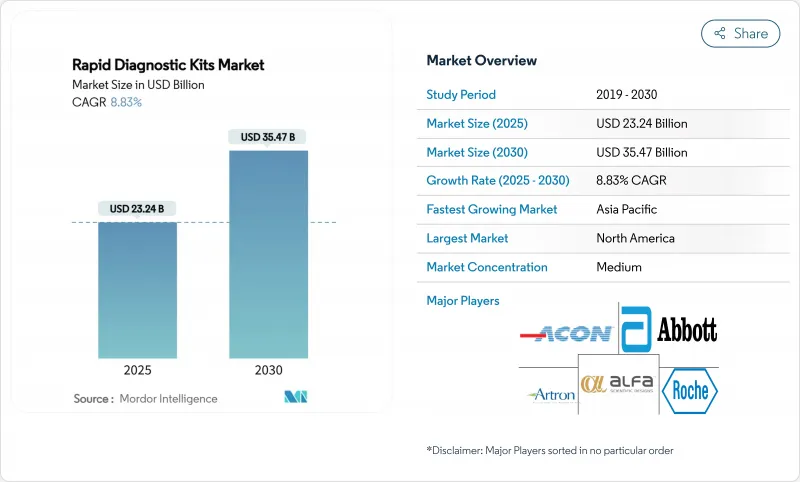
|
市場調査レポート
商品コード
1851725
迅速診断キット:市場シェア分析、産業動向、統計、成長予測(2025年~2030年)Rapid Diagnostic Kits - Market Share Analysis, Industry Trends & Statistics, Growth Forecasts (2025 - 2030) |
||||||
カスタマイズ可能
適宜更新あり
|
|||||||
| 迅速診断キット:市場シェア分析、産業動向、統計、成長予測(2025年~2030年) |
|
出版日: 2025年07月29日
発行: Mordor Intelligence
ページ情報: 英文 120 Pages
納期: 2~3営業日
|
概要
迅速診断キット市場規模は2025年に232億4,000万米ドルと推定され、予測期間(2025~2030年)のCAGRは8.83%で、2030年には354億7,000万米ドルに達すると予測されます。

この拡大は、ポイントオブケア導入の増加、病院予算の逼迫、エピソードケアから予防ケアへの世界的なシフトを反映しています。多項目検出を可能にする技術のアップグレードは、慢性疾患モニタリングのための支援償還と並んで、急性パンデミックの波が去った後も需要の増加を維持します。メーカー各社は、研究開発リスクを軽減する政府資金から恩恵を受ける一方、高齢化によってプライマリーケアや在宅ケアの現場での検査量が増加しています。病院と消費者の両方が電子カルテとのシームレスな統合を期待しているため、競合戦略は現在、規模、垂直統合、データ接続に焦点を当てています。
世界の迅速診断キット市場の動向と洞察
マルチプレックス呼吸器パネルに対する政府資金の急増
公的機関は、SARS-CoV-2、インフルエンザA/B、RSVを1つのカートリッジで検査するマルチプレックス呼吸器パネルに資金を供給し続けており、サプライヤーは複数年の受注を確保しています。BARDAの支出は、2024年5月に認可されたロシュの20分コバス・リアット・トリプルアッセイに代表されるように、プロトタイプから市場投入までのスケジュールを早めています。病院がシンドロミックモデルを採用する理由は、1回のスワブでサンプルの取り扱いを簡略化し、隔離の判断を短縮し、個人防護具を節約できるからです。検査室は業務上の節約を実現し、メーカーはプラットフォームの小型化を正当化するボリュームコミットメントを確保します。このモデルは現在、新興の病原体パネルに移行しつつあり、迅速診断キット市場の範囲を広げ、分子サプライヤーの収益基盤を固めつつあります。
慢性疾患の自己検査に対する消費者の支持の高まり
自己検査は妊娠キットにとどまらず、心代謝系疾患や感染症モニタリングにも進出しています。LabcorpのFirst-to-Know梅毒キットは、細菌性STIのための初のFDA認可の市販血液検査であり、自宅での毛細管サンプリングに対する消費者の準備態勢を検証しました。ケアチームのために結果を管理するデジタル・ヘルス・プラットフォームは、診療所の受診を減らし、検査室の遅延なしに投薬の滴定を可能にします。直接支払キットにより、繰り返しの瀉血に関連する請求が減少するため、支払者も利益を得ることができます。糖尿病前症のデジタル検出に関する規制ガイダンスの草案は、非侵襲的スクリーニングに対する公式な支持を強調しており、サプライヤーはBluetoothやNFC接続を組み込んで即座にデータをアップロードすることで対応しています。このような行動シフトは、迅速診断キット市場においてホームケアが最速のエンドユーザーチャネルであることを裏付けています。
重要試薬のサプライチェーンの脆弱性
特殊な抗体、酵素、緩衝液は、東アジア全域の単一施設で生産されることが多いです。貿易摩擦やパンデミックが発生すると輸出はすぐに停止し、納期を延ばしコストを上昇させる割り当てプロトコルを余儀なくされます。COVID-19危機は、酵素不足がPCRキットの生産量を制限したときに、こうした隘路を露呈しました。メーカー各社は現在、試薬の二重生産か内製化を進めているが、資本支出は投資回収期間を長くし、中小企業を圧迫しています。混乱は、特に在庫バッファーのない低所得地域において、公共診療所から必要不可欠な診断薬が供給されなくなる可能性があり、冗長化計画が成熟するまで迅速診断キット市場を抑制します。
セグメント分析
ラテラルフロー免疫測定法は、成熟したサプライチェーン、低単価、パンデミック急増時の迅速なスケールアップ能力に支えられ、2024年の売上高で42.76%を占め、迅速診断キット市場で最大のシェアを獲得しました。この分野は、常温に耐え、最小限のトレーニングで済むことから、資源が限られた診療所、人道的任務、集団スクリーニング・プログラムなどで成長を続けています。ナノ粒子ラベルや改良された膜の多孔性などの進歩により分析感度が向上し、検査室での期待が高まる中でもラテラルフローがシェアを維持できるようになっています。イムノクロマトグラフィは規模は小さいが、半定量的な出力を求める医師の需要の高まりと、より豊かなデータ層を解き放つAI支援リーダーによって、CAGR最速の9.17%を記録しています。マイクロ流体ラボオンチップシステムは、マイクロリットル容積と高精度が重要な内分泌学と新生児スクリーニングの分野で前進しています。等温増幅法やCRISPR編集法を用いた分子迅速測定法は、呼吸器系や消化器系のターゲットを束ねた症候学的パネルに資本投下し、二桁成長を記録します。バイオセンサープラットフォームは、電気化学的検出を活用して連続的なグルコースや心臓バイオマーカーの動向を捉え、対応可能な迅速診断キット市場全体を拡大しています。
組み合わせシステムの着実なパイプラインは、ラテラルフローカートリッジと核酸捕捉モジュールを統合したものです。このようなハイブリッドは、より少ない試薬使用量、1つのストリップで3つのターゲット検出、クラウドダッシュボードと同期するスマートフォン読み取りを約束します。FDAが2025年1月に発表した新興病原体パネルのバリデーション・ガイダンスは、このようなデザインのクリアランスを加速させる。病院がサプライヤーを合理化するにつれて、技術の差別化は、検出化学のみではなく、スループット、サンプルタイプの多様性、組み込み接続性にかかっています。独自の試薬とオープン分析ソフトウェアを組み合わせたメーカーは、迅速診断キット市場において耐久性のある足場を築いています。
感染症は2024年の売上高の36.03%を占め、インフルエンザ、RSV、抗菌薬耐性のサーベイランスが好調です。しかし、腫瘍マーカーはCAGR 9.46%で最も急速に進展しています。政策立案者が治療費抑制のために早期発見を支持しているからです。ポイントオブケアFIT検査、メチル化DNA用リキッドバイオプシーカートリッジ、VolitionRx社の敗血症指標などのヌクレオソームアッセイなどが、腫瘍学にスポットライトを当て続けています。高血圧や糖尿病の管理が薬局や家庭に移行するにつれて、心臓・代謝モニタリングが増加します。妊娠と不妊治療キットは、後期妊娠と遠隔生殖医療サービスによって拡大し、ベースライン量を維持します。毒物検査と乱用薬物検査パネルは、オピオイド政策の変化と今後の連邦職場規則改正に合わせて進化します。
獣医学および人獣共通感染症スクリーニングは、現在小規模ではあるが、動物とヒトの疾病警戒を統合するOne Healthの枠組みから恩恵を受けています。LMICsにおける感染症検査のための迅速診断キット市場規模は、多国間助成金によって支えられています。このように、アプリケーションの多様化は、周期的な需要の変動からサプライヤーを守り、多目的プラットフォームをクロスセクターの収益につなげます。
地域分析
北米は2024年の売上高の38.17%を占め、有利な償還コード、高いデジタルリテラシー、継続的にイノベーションを生み出すBARDAパイプラインに支えられています。米国は、ロシュの20分間STI検査がCLIA免除を受け、12,000の小売クリニックに広く展開されていることから、大半のシェアを占めています。カナダは、ファースト・ネーションズ(先住民族)のコミュニティに対する国家入札プログラムを通じて、HIVとC型肝炎のカートリッジをプライマリケアのツールキットに追加しています。同地域はまた、電子カルテと統合するAIリーダーの試験的導入でもリードしており、迅速診断キット市場の早期導入者に先行者利益をもたらしています。
アジア太平洋地域のCAGRは11.15%と最も高く、公的保険の拡大や政府による体外診断用医薬品の国産化奨励策が拍車をかけています。中国の自給自足の推進により、試薬をリバースエンジニアリングして輸入品を下回るようにした現地サプライヤーが台頭し、一方、第2級都市病院は新しい呼吸器監視義務に対応するためにポータブルPCR分析装置を調達しています。インドはアユシュマン・バラット・デジタル・ミッションを通じて遠隔医療を拡大し、地域医療従事者のキットに迅速代謝パネルを組み込んでいます。東南アジアの省庁はモンスーンの季節にデング熱とCOVIDを組み合わせたカートリッジを配備し、日本の老人クリニックは唾液ベースの認知症バイオマーカーを試験的に導入しています。この地域の異質性が多様な需要パターンを生み出しているが、メンテナンスが容易でクラウドに接続されたシステムという共通のニーズに集約されています。
欧州は、国境を越えたデバイスの受け入れを保証するIVDR規則の調和に支えられ、1桁台半ばの着実な成長を維持しています。ドイツは介護施設でのAI支援によるラテラル・フロー・プラットフォームに資金を提供し、フランスは循環器専門医の待ち時間を短縮するために薬局ベースの心代謝検査に補助金を出しています。中東・アフリカでは、石油国家がラボのインフラを整備しているため、結核やMPOX検出の入札活動が加速しているが、遠隔地では依然として流通が妨げられています。ラテンアメリカでは、デング熱、ジカ熱、チクングニアを区別するマルチプレックスアッセイで、アルボウイルスの共同感染に取り組んでいます。世界基金のような地域横断的なドナープログラムが需要を集約し、為替変動を平準化することで、新興地域全体の迅速診断キット市場規模を支えています。
その他の特典:
- エクセル形式の市場予測(ME)シート
- 3ヶ月間のアナリストサポート
よくあるご質問
目次
第1章 イントロダクション
- 調査の前提条件と市場の定義
- 調査範囲
第2章 調査手法
第3章 エグゼクティブサマリー
第4章 市場情勢
- 市場概要
- 市場促進要因
- マルチプレックス呼吸器パネルに対する政府資金の急増
- 慢性疾患の自己検査の消費者普及の高まり
- LMICsにおける分散型分子PoCプラットフォームの拡大
- 検査精度を向上させるAI対応リーダーの統合
- CRISPRを用いた超高速アッセイの登場
- 疾病に対する意識の高まりが検診需要を牽引
- 市場抑制要因
- 重要試薬のサプライチェーンの脆弱性
- 家庭用マルチプレックスキットの規制上の不確実性
- リーダー・デバイスのデータープライバシーへの懸念
- 単一使用プラスチックに対する持続可能性への圧力
- 規制情勢
- テクノロジーの展望
- ポーターのファイブフォース分析
- 買い手の交渉力/消費者
- 供給企業の交渉力
- 新規参入業者の脅威
- 代替品の脅威
- 競争企業間の敵対関係
第5章 市場規模と成長予測(単位:米ドル)
- 技術別
- ラテラルフロー免疫測定法
- マイクロ流体ラボオンチップ
- 免疫クロマトグラフィー
- 凝集&ラテックス検査
- バイオセンサーベースの迅速検査
- 分子迅速検査
- 用途別
- 感染症
- 心臓代謝モニタリング
- 妊娠と不妊
- 毒物学と乱用薬物
- 腫瘍マーカー
- 獣医学および人獣共通感染症スクリーニング
- サンプルタイプ別
- 血液
- 鼻腔
- 尿
- 唾液
- スツール
- エンドユーザー別
- 病院&クリニック
- 医師オフィス&緊急医療
- ホームケア
- 診断ラボ
- その他のエンドユーザー
- 地域別
- 北米
- 米国
- カナダ
- メキシコ
- 欧州
- ドイツ
- 英国
- フランス
- イタリア
- スペイン
- その他欧州地域
- アジア太平洋地域
- 中国
- 日本
- インド
- オーストラリア
- 韓国
- その他アジア太平洋地域
- 中東・アフリカ
- GCC
- 南アフリカ
- その他中東・アフリカ
- 南米
- ブラジル
- アルゼンチン
- その他南米
- 北米
第6章 競合情勢
- 市場集中度
- 市場シェア分析
- 企業プロファイル
- Abbott Laboratories
- F. Hoffmann-La Roche AG
- Danaher Corp.(Cepheid)
- Becton, Dickinson & Co.
- bioMerieux SA
- Siemens Healthineers
- QuidelOrtho Corp.
- Thermo Fisher Scientific
- Qiagen NV
- Hologic Inc.
- SD Biosensor Inc.
- OraSure Technologies Inc.
- Access Bio Inc.
- Alfa Scientific Designs Inc.
- ACON Laboratories Inc.
- BTNX Inc.
- Artron Laboratories Inc.
- LumiraDx Ltd.
- Bio-Rad Laboratories Inc.
- DiaSorin(Luminex)
- SureScreen Diagnostics
- Creative Diagnostics
- Biopanda Reagents

